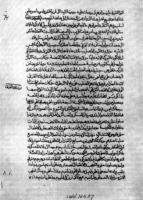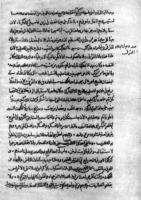Description of trip to Moscow
N.I. Zharkikh
Paul became famous that conducted a detailed travel diary, which is a first-class historical source. Let us note that preserved only records of his first tour, which will be further talks. Likely that during the second journey Paul also led the diary, but it still is not found (probably perished without a trace).
There are following manuscripts of Macarius' journey description known:
1. London manuscript (a manuscript of the British Museum), purchased by Count Frederick Hilford in 1824 in Aleppo. It was rewritten in 1765 and consists of 4 large volumes. This valuable manuscript contains the complete version of work. Yes, it describes the beginning of the journey from Aleppo through Asia Minor to Istanbul, Makarius' stay in Istanbul and the sea voyage to Constanza, also it contains a detailed description of the back path of Makarius and his first steps since his return. Please be aware that in the late 19 century this manuscript was considered lost, which was reflected in several publications of the time. Fortunately, later the manuscript was discovered.
2. Paris manuscript (manuscript of the Paris National Library.) It was deposed to the library in the collection of French orientalist C. Schaefer (1820 – 1898) in late 19 century. Brief details about it were first published in 1901. It is the oldest of the manuscripts (dated 17 century). It copied by the two handwritings, and it was suggested that at least part of the manuscript was Paul's autograph. This assumption is controversial, so this issue and manuscript a whole needs further investigation.
3. Damascus manuscript rewritten in 1700. This manuscript gives an abbreviated version of the description (especially important for us that the description of the back path through Ukraine in 1656, reduced from dozens of pages to a few sentences). In the 19 century there were made three copies of this manuscript: in 1847 – a manuscript of the Training Department of the Ministry of Foreign Affairs (later – St. Petersburg Branch of the Institute of Oriental Studies); in 1849 – a manuscript, ordered by Porfirio Uspensky and submitted to the Public Library (St. Petersburg); in 1859 – a manuscript, ordered by the director of the Moscow main archives of the Ministry of Foreign Affairs M.A. Obolensky (preserved in this archive). This last manuscript was the basis of Russian translation by G.A. Murkos.
In 1913, celebrating 300 years of the Romanov's house ruling in Russia, Patriarch of Antioch Gregory 4 (1859 – 1928) made a valuable gift to Emperor Nicholas 2nd. The gift consisted of 42 manuscripts, including the Damascus manuscript of journey, photocopy of London manuscript and some autographs by Patriarch Macarius and Paul of Aleppo. In 1919, Damascus manuscript and copies were sent to the Institute of Oriental Studies in St. Petersburg, where they are stored now (messages that Damascus manuscript was burned in 1860, fortunately, turned out to be a false).
4. Kyiv manuscript purchased in 1896 by A. Krymsky during his trip to Syria. It was copied somewhere in the middle of 18 century, burnt, has no beginning and end. As for content it is reducing (epitoma) of primary version. A. Krymsky, considering this manuscript, found in it few places that allow one to make corrections to the translation of G. Murkos. A. Olesnytsky found within this manuscript fragments that complement translations by Belfour and Murkos. When A. Krymsky became secretary of the Ukrainian Academy of Sciences, he handed the manuscript, which was his private property, to the Academy. Ukrainian Arabist Taufik Kezma completed the translation of this manuscript, which still lies in the archives of the Academy of Sciences unused.
5. Aleppo manuscript of 1750, which by description Syrian scholar K. Bash recalled by Krachkovsky. This manuscript appears to be close to the Paris manuscript.
A notable feature is that all description's manuscripts were discovered in 19 – early 20 centuries. And for the past 100 years, the fund of manuscripts was not filled with new discoveries. Apparently, all stored texts have been found, and there is little hope of finding new manuscripts.
Paul has worked on describing long time (if not to the end of life). During the trip he made draft records that were later processed in a fair description. Krachkovsky assumed that Paul made the first (brief) version of description during his long stay in Moscow, not later than February 1656.
Paul himself describes his work in these words:
I strained my eyes, thoughts and feelings, has made great efforts and a lot of work, while extract this story from crude notebooks, when I had finished a year after they were written. (Murkos, v. 3, p. 30)
Know, my brother, that the information that I submit, are not subject to any doubt, because when I again came to Moscow from the country of Georgia, accompanied the patriarch of Egypt and my father, I thoroughly checked and confirmed all these details (Murkos, v. 5, preface, p. 3 – from London manuscript).
From this we can conclude that the full version of description was concluded by Paul in Syria somewhere between the two trips (ie in 1659..1666 years), and later, during a second visit to Moscow, Paul continued to make additions to it. If one understand the expression "when they fail year after writing" literally, it will turn out that Paul work out a description for one year after return, ie in 1659 – 1660's. But this expression can be understood and so that Paul continued to keep their records for one year after their return (the end of his work actually contains a detailed description of how Paul and Macarius ruled his patriarchate in 1659 – 1661, including description of Paul's construction activities in Damascus and Aleppo).
Description consists of 15 books (in brackets shows the volume of books – the number of pages in G. Murkos' translation):
1 – from Aleppo to Moldavia; (43 p.)
2 – stay in Moldavia, (69 p.).
3 – stay in Wallachia; (58 p.)
4 – travel through Ukraine, stay in Kyiv; (80 p.)
5 – trip from Kyiv to Kolomna; (64 p.)
6 – stay in Kolomna; (54 p.)
7 – stay in Moscow; (57 p.)
8 – stay in Moscow; (63 p.).
9 – stay in Moscow; (94 p.).
10 – stay in Moscow, a trip to the Trinity-Sergius monastery and return to Moscow; (57 p.)
11 – journey to Novgorod and return to Moscow; (61 p.)
12 – visit to Savvyn monastery and return to Moscow, the back way through Russia and Ukraine to Moldavia border; (75 p.)
13 – stay in Moldavia and Wallachia; (66 p.)
14 – stay in Wallachia; (43 p.)
15 – way back through the Black Sea, Asia Minor and Syria. Actions of Makarius and Paul to manage patriarchate in 1659 – 1661 years (70 p.).


